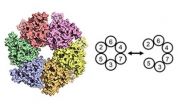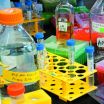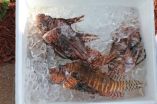(Press-News.org) In a study published today in Genes & Development, Dr Christian Speck from the MRC Clinical Sciences Centre's DNA Replication group, in collaboration with Brookhaven National Laboratory (BNL), New York, reveal the intricate mechanisms involved in the enzyme that governs DNA duplication during cell division. By developing a sophisticated system using synthetic, chemical and structural biology approaches, the study reveals how a key enzyme involved in duplicating genetic information embraces DNA through a gated system, which opens up at precise positions allowing for a highly regulated replication process. This work enhances current understanding of an essential biological process and suggests a route for stopping cell division in disease such as cancer.
When a cell divides, genetic information is duplicated in a process known as DNA replication. For this to occur, a 'replication machine' is assembled on top of the DNA prior to duplication. A protein complex known as ORC that recognises the DNA replication origin initiates the whole process. Next, an enzyme, MCM2-7 helicase, whose role is to unwind and separate the two strands of the DNA helix, is loaded onto the DNA by the machine system ORC. The helicase is a ring shaped enzyme composed of six subunits (hexamer), though how the ring structure opens and encircles the DNA has, until now, remained a mystery.
Initial theories within in field assumed the helicase to exist in an open ring conformation. Speck's team argued that this would undoubtedly lead to poorly regulated DNA replication with no control or specificity. To examine the helicase activity in more detail, Jingchuan Sun at BNL used an electron microscope and revealed, contrary to initial theories, the helicase actually existed as a closed ring conformation.
To pinpoint where within the six subunits, the helicase opens to encompass the DNA, the team generated linkages that blocked ring opening at various positions. They found that if they blocked one specific interface, between MCM2 and MCM5, DNA could not enter. A small molecule called rapamycin brings the linkages together; such a molecular switch can be used to control DNA entry to the MCM ring and subsequent DNA replication. "Both in the context of our in vitro and in vivo experiments, we showed that opening of the MCM2/MCM5 interface is essential for helicase loading onto DNA," explains Christian.
"The field has known for a while that DNA can pass into the MCM2-7 ring, but has never been sure which MCM subunits are used for regulated helicase loading. By designing an elegant experiment, the Speck laboratory has now shown once and for all that the MCM2-5 is the only DNA entry point," says collaborator Huilin Li at BNL.
In eukaryotes, the MCM2-7 helicase forms a double hexamer (with another MCM2-7 unit) when it is loaded onto DNA. In this study, the group also settled the longstanding dispute surrounding whether the helicase is actually loaded as a single hexamer, which then dimerises, or is loaded as a dimer at the offset. They concluded that the helicase is in fact loaded as a single hexamer before forming a double hexamer.
In a successful collaboration that harnesses the electron microscopy expertise at BNL with the chemical biology and genetic expertise at the MRC Clinical Sciences Centre, the study addresses key questions detailing the processes involved in DNA replication. "Our work is aimed at understanding the molecular mechanism of DNA replication at a fundamental level. Yet our findings could also have important implications, possibly pointing to new ways to fight cancer, because DNA duplication is a prime target to inhibit cancer cell growth," says Christian.
INFORMATION:
This work was supported by the MRC. The first author, Stefan Samel, was supported by a Fellowship from the German Research Foundation (DFG).
Reference: Samel AS, Fernández-Cid A, Riera A, Tognetti S, Herrera MC, Speck C (2014) A unique DNA entry gate for regulated loading of the eukaryotic replicative helicase onto DNA. Genes & Development, 28 (15)
Molecular gate that could keep cancer cells locked up
Identification of new molecular mechanism indicates new ways to block uncontrolled cell division
2014-08-01
ELSE PRESS RELEASES FROM THIS DATE:
SwRI-led team's research shows giant asteroids battered early Earth
2014-08-01
San Antonio — July 31, 2014 — A new terrestrial bombardment model developed by an international group of scientists led by Southwest Research Institute (SwRI) indicates that Earth's surface was heavily reprocessed — or melted, mixed and buried — as a result of giant asteroid impacts more than four billion years ago.
The model, calibrated using existing lunar and terrestrial data, sheds light on the role asteroid collisions played in the geological evolution of the uppermost layers of Earth during the geologic eon call the "Hadean," or first geologic eon, approximately ...
Blood and saliva tests help predict return of HPV-linked oral cancers
2014-07-31
Physicians at Johns Hopkins have developed blood and saliva tests that help accurately predict recurrences of HPV-linked oral cancers in a substantial number of patients. The tests screen for DNA fragments of the human papillomavirus (HPV) shed from cancer cells lingering in the mouth or other parts of the body. A description of the development is published in the July 31 issue of JAMA Otolaryngology – Head & Neck Surgery.
"There is a window of opportunity in the year after initial therapy to take an aggressive approach to spotting recurrences and intensively addressing ...
Study of twins discovers gene mutation linked to short sleep duration
2014-07-31
DARIEN, IL – Researchers who studied 100 twin pairs have identified a gene mutation that may allow the carrier to function normally on less than six hours of sleep per night. The genetic variant also appears to provide greater resistance to the effects of sleep deprivation.
Results show that a participant with p.Tyr362His – a variant of the BHLHE41 gene – had an average nightly sleep duration of only five hours, which was more than one hour shorter than the non-carrier twin, who slept for about six hours and five minutes per night. The twin with the gene mutation also ...
Sustained efficacy, immunogenicity, and safety for GlaxoSmithKline's HPV vaccine
2014-07-31
A long-term follow-up study (HPV-023; NCT00518336) shows the sustained efficacy, immunogenicity and safety of GlaxoSmithKline's human papilloma virus (HPV) vaccine Cervarix. Women vaccinated with the HPV-16/18 AS04-adjuvanted vaccine were followed for more than nine years, and vaccine efficacy (VE) against incident infection was 100%. This is the longest follow-up report for a licensed HPV vaccine. Visit https://www.landesbioscience.com/journals/vaccines/article/29532/ for the full paper.
HPV and vaccination
Persistent infection with HPV has been clearly established ...
Algorithm reduces use of CT scans when diagnosing children with appendicitis
2014-07-31
ROCHESTER, Minn. — Implementation of an algorithm aimed to diagnose pediatric patients with suspected appendicitis reduces the utilization of computed tomography (CT) scans, without affecting diagnostic accuracy, Mayo Clinic Children's Center researchers have found. The study was recently published in the journal Surgery.
Acute appendicitis is the most common cause of acute abdominal pain in children. Appendicitis occurs when the appendix becomes inflamed and filled with pus. CT scans are often used to diagnose acute appendicitis because they are accurate, widely available ...
Study of bigeye tuna in Northwest Atlantic uses new tracking methods
2014-07-31
AMHERST, Mass. – A first-of-its-kind study of bigeye tuna movements in the northwestern Atlantic Ocean led by Molly Lutcavage, director of the Large Pelagics Research Center at the University of Massachusetts Amherst, found among other things that these fish cover a wide geographical range with pronounced north-south movements from Georges Bank to the Brazilian shelf, and they favor a high-use area off Cape Hatteras southwest of Bermuda for foraging.
This NOAA-funded research, which used a new approach to study one of the most important commercial tuna species in the ...
Unintended consequences: More high school math, science linked to more dropouts
2014-07-31
As U.S. high schools beef up math and science requirements for graduation, researchers at Washington University in St. Louis have found that more rigorous academics drive some students to drop out.
The research team reported in the June/July issue of the journal Educational Researcher that policies increasing the number of required high school math and science courses are linked to higher dropout rates.
"There's been a movement to make education in the United States compare more favorably to education in the rest of the world, and part of that has involved increasing ...
Is it really a concussion? Symptoms overlap with neck injuries so diagnosis is tough call
2014-07-31
BUFFALO, N.Y. – Athletes and others reporting cognitive difficulties after a head injury are usually diagnosed as having had a concussion. But is it really a concussion? A new study published by University at Buffalo medical faculty finds that many of the same symptoms are common to concussions and to injuries to the neck and/or balance system, known collectively as cervical/vestibular injuries.
The research was based on responses about symptoms from 128 patients – some of whom were professional athletes – who were being treated at UB's Concussion Management Clinic in ...
Invasive lionfish likely safe to eat after all
2014-07-31
Scientists have learned that recent fears of invasive lionfish causing fish poisoning may be unfounded. If so, current efforts to control lionfish by fishing derbies and targeted fisheries may remain the best way to control the invasion. And there's a simple way to know for sure whether a lionfish is toxic: test it after it's been cooked.
Pacific lionfish were first reported off the coast of Florida in the 1980s, and have been gaining swiftly in number ever since. They're now found in marine habitats throughout the tropical and subtropical Western Atlantic, Caribbean ...
Certain Arctic lakes store more greenhouse gases than they release
2014-07-31
New research, supported by the National Science Foundation (NSF), counters a widely-held scientific view that thawing permafrost uniformly accelerates atmospheric warming, indicating instead that certain Arctic lakes store more greenhouse gases than they emit into the atmosphere.
The study, published this week in the journal Nature, focuses on thermokarst lakes, which occur as permafrost thaws and creates surface depressions that fill with melted fresh water, converting what was previously frozen land into lakes.
The research suggests that Arctic thermokarst lakes ...
LAST 30 PRESS RELEASES:
How do childcare tax credits affect children’s long-term health?
Can an electronic nose detect indoor mold?
Do natural disasters have long-term impacts on mortality in older adults?
Modification improves sodium‐ion batteries as an alternative to lithium-ion batteries
Parasports provide a range of benefits for people with cerebral palsy
How does grandparental care affect children’s health?
Why are there so many Nordic mediators?
Young shark species more vulnerable to extinction
Mobile fetal heart monitoring linked to fewer newborn deaths in Tanzania
Bluey’s dad offered professorial chair in archaeology at Griffith University
Beyond small data limitations: Transfer learning-enabled framework for predicting mechanical properties of aluminum matrix composites
Unveiling non-thermal catalytic origin of direct current-promoted catalysis for energy-efficient transformation of greenhouse gases to valuable chemicals
Chronic breathlessness emerging as a hidden strain on hospitals
Paleontologists find first fossil bee nests made inside fossil bones
These fossils were the perfect home for ancient baby bees
Not everyone reads the room the same. A new study examines why.
New research identifies linked energy, immune and vascular changes in ME/CFS
Concurrent frailty + depression likely boost dementia risk in older people
Living in substandard housing linked to kids’ missed schooling and poor grades
Little awareness of medical + psychological complexities of steroid cream withdrawal
Eight in 10 trusts caring for emergency department patients in corridors, finds BMJ investigation
NASA’s Webb telescope finds bizarre atmosphere on a lemon-shaped exoplanet
The gut bacteria that put the brakes on weight gain in mice
Exploring how patients feel about AI transcription
Category ‘6’ tropical cyclone hot spots are growing
Video: Drivers struggle to multitask when using dashboard touch screens, study finds
SLU research shows surge in alcohol-related liver disease driving ‘deaths of despair’
Rising heat reshapes how microbes break down microplastics, new review finds
Roots reveal a hidden carbon pathway in maize plants
Membrane magic: FAMU-FSU researchers repurpose fuel cells membranes for new applications
[Press-News.org] Molecular gate that could keep cancer cells locked upIdentification of new molecular mechanism indicates new ways to block uncontrolled cell division





